19世纪的美国家庭生活
从家屋社会到政治社会——评摩尔根《美洲土著的房屋和家庭生活》

从家屋社会到政治社会——评摩尔根《美洲土著的房屋和家庭生活》摩尔根的《美洲土著的房屋和家庭生活》是19世纪中叶美国人类学家和考古学家摩尔根对美洲土著社会的研究成果,通过对土著房屋和家庭生活的考察,摩尔根揭示了房屋和家庭在社会发展中的重要地位。
本文将结合摩尔根的研究成果,从家屋社会到政治社会的角度来评述并展开讨论。
首先,摩尔根通过对美洲土著的房屋和家庭生活的考察,提出了“家屋社会”的概念。
他发现,土著社会的房屋和家庭是社会关系的核心和基础,具有很强的经济、社会和政治意义。
土著族群通过家庭和房屋的组织和建设,形成了清晰的社会等级和分工,家族间的关系也非常密切。
摩尔根认为,家庭和房屋是土著社会内外联系的纽带,对土著社会的稳定和发展起到了重要的作用。
其次,摩尔根将研究范围扩展到政治生活领域,提出了“政治家庭”的概念。
他认为,家庭的组织和房屋的建设不仅仅是满足物质层面的需求,更是体现了土著族群政治生活的特点和表现形式。
摩尔根注意到,土著社会的政治生活与家庭和房屋的组织紧密相关,政治权力和地位主要通过家庭的继承和传承来决定。
因此,家庭和房屋不仅仅是居住的场所,更是政治权力的象征。
摩尔根的研究成果对后来的社会学和人类学研究产生了深远的影响。
他的《美洲土著的房屋和家庭生活》为我们理解社会发展和政治生活提供了重要的思路和框架。
通过对家庭和房屋的研究,我们可以更好地把握社会结构和组织的原理,理解不同社会群体的相互关系和社会差异。
然而,摩尔根的研究也存在一些局限和问题。
首先,在研究对象的选择上,摩尔根主要关注的是美洲土著社会,这在一定程度上限制了他的研究视野和推广性。
其次,在理论框架的构建上,摩尔根主要采用了演化主义的思维方式,将社会发展看作是一个线性的过程,这种简化和概括的思维可能忽略了社会发展的多样性和复杂性。
综上所述,摩尔根的《美洲土著的房屋和家庭生活》通过对土著社会的研究,揭示了家屋社会和政治社会之间的联系和转变。
从女性主义文学批评角度看凯特·肖邦的《觉醒》

文学评论·外国文学从女性主义文学批评角度看凯特•肖邦的《觉醒》宋付霞 吉林大学公共外语教育学院摘 要:美国女作家凯特·肖邦的长篇小说《觉醒》是一部美国文学史上的经典之作,标志着妇女文学崭新时代的到来。
小说谈及了一位女性主体意识觉醒的心路历程,包括精神觉醒和性觉醒。
本文将从女性主义文学批评的视角出发,深入剖析女主人公艾德娜自我意识觉醒与困惑的过程,并结合对一些象征和意象的分析,揭示她渴望自由、追求独立人格的内在精神。
关键词:凯特·肖邦;《觉醒》;女性主义文学批评作者简介:宋付霞(1990-),女,汉族,山东省临沂市人,吉林大学公共外语教育学院外国语言学及应用语言学专业硕士研究生。
[中图分类号]:I106 [文献标识码]:A[文章编号]:1002-2139(2017)-14-114-02凯特·肖邦(Kate Chopin, 1850-1904) 是美国19世纪著名的女性主义作家,被誉为“美国女性的先驱者”。
[1]1899年,她的长篇小说《觉醒》(The Awakening) 问世,在当时美国文化界掀起了一场轩然大波。
它描述了女性自我意识的觉醒,鼓励女性摆脱男权社会的桎梏去追求独立自由的生活。
因此,不仅被一些评论家和报刊杂志大肆抨击,认为它伤风败俗,而且图书馆不予收藏,视其为禁书。
直到20世纪50年代后,第二次女权运动的兴起,《觉醒》和它的作者凯特·肖邦才被重新发掘并得以重见天日。
法国评论家西里尔·阿纳翁(Cyrille Arnavon)于1953年率先将其译为法文,认为它运用写实主义手法坦诚严肃地描写了婚姻和性的问题,足以媲美《包法利夫人》。
[2]另外,挪威人佩尔·赛耶斯特德(Per Seyersted) 在1969年为凯特·肖邦作传,以崭新的角度诠释了书中“女性对自我的肯定与追求”。
[3]如今,它已经被公认为美国文学史上的一部经典之作,标志着女性主义文学新时期的开始。
第五章 美国人的家庭和家庭婚姻观

(8)群居(communal living)
1960年代性解放运动之后,婚姻家庭神圣性被扫 荡一空,男女性爱的秘密被揭露,对一切都显得无 所谓的西方年轻一代,其中有相当一部分再也不愿 意像父辈那样自我约束、小心谨慎地过日子,他们 从家庭里走出来,自发地聚集在一起,组成了一个 又一个现代人群居部落。 这种单身群体生活试验在70年代形成高峰,90年 代开始进入低潮,但是依然没有完全消失。 群居村试验者自己在面对情感、性爱、生育、子女 抚养,以及父子关系确立等一系列复杂问题时也是 束手无策。
(2)对妇女的影响
美国当代妇女确实争得了更多的自由和更大 的权力,但却并未得到相应的幸福。 从经济上看,研究显示,离婚会导致家庭的 收入减少和贫困风险的加大。 单亲家庭尤其是单亲母亲家庭的贫困率非常 高。 家庭和婚姻模式的变动对成年人的情感和生 理的影响也越来越多得到研究成果的证实。
四、当代美国人家庭与婚姻模式演变原因及 其影响
1、影响美国人家庭与婚姻模式变化的因素: (1)价值观的变化。 (2)物质至上主义与竞争性环境的影响。 (3)婚姻和家庭中性别角色的转变。 (4)社会的认同与法律的更改。 (5)房地产业的发展。
(1)价值观的变化
个人主义和享乐主义开始盛行,这些对美国 人强调责任、利他和自我约束的传统价值观 造成极大的破坏,也对美国人的家庭与婚姻 模式产生了巨大冲击。 个人主义和享乐主义是核心家庭减少、离婚 率和非婚同居等现象上升的重要原因。
第五章 美国人的家庭和家庭婚姻观
一、美国家庭的历史演变 二、现代美国家庭婚姻及家庭婚姻观 三、现代美国家庭结构和婚姻模式的变化 四、当代美国人家庭与婚姻模式演变原因及其影 响
一、美国家庭的历史演变
1、工业化前的美国家庭 农业社会里,农场家庭既是生产单位、生育单位 (繁衍后代)、生活单位,又是教育单位、分配单 位。 家庭结构:扩大家庭(extended family):几 代同堂、家庭人口众多、生育率高。 家庭成员之间的关系以父权为中心。 婚姻基础:主要是物质上的依赖、父母的意志、双 方经济条件和宗教信仰。(男女之间感情较少)
小妇人的读书心得笔记

小妇人的读书心得笔记1、小妇人的读书心得笔记《小妇人》是一本带有自传性质的家庭小说,它的是美国的路易莎·奥尔科特。
小说以19世纪末期的美国家庭生活为题材,生动的描述了马奇一家四姐妹从懵懂少女变成小妇人的成长经历。
《小妇人》中描写的故事围绕家庭生活展开,给读者讲述了生活中平凡的小事,我们能从其中找到最真实的自己。
文中,有一件事给了我很大的启发。
马奇先生从军队寄来了信,在艰辛的岁月里,几乎每封书信都会勾起人们的伤感。
而马奇这封信中却很少提到困苦、危险、想、思乡,这是一封充满了希望、喜悦的书信,很多内容是对军队生活的描述,只有信末,写信人才将自己对家中女儿们的爱与关怀寄托于文字之中。
从信中可以看出马奇先生是一个乐观向上、不怕困难的人,他很想念女儿和妻子,他爱女儿也爱家,只字未提自己的困苦,把关爱充分的表现出来,父亲的信给了孩子们很大的鼓励,让他们能成功的认识到自己的价值。
有一段时间,大姐玛格丽特去安妮·莫法特家中参加了两个礼拜的游乐,其中有舞会,回来后,她变成了爱慕虚荣的女孩。
文中有这么一段话“只要这种喜欢不变成一种癖好,引导你去做愚蠢或不害臊的事,那么这样的心态就十分正常,玛格丽特,你要学着去认识,去珍视那些值得拥有的赞美,更要在美貌之外,凭借娴熟质朴的德行去赢取赞美。
”引导我们不去追求那些华而不实的东西,去寻找心灵的真善美,女孩子喜欢精致漂亮的东西可以,但是不能一味的追求这种无用的东西,要做好本质的自己。
在文章最后,除了贝斯的去世,所有人都拥有了美满的家庭,过上了幸福的生活,这天伦之爱让我深受感动,她的脸庞上、声音里洋溢着慈母的关爱和谦逊。
“哦!我的孩子们,无论这一生有多长,但愿你们能永远的如此幸福快乐。
”小说的结局很美好。
一家十二个人其乐融融的在一起,永远快乐。
这四个女孩是世间所有少女的缩影,从他们身上,我们既能看到情窦初开的少女对美好爱情的执着追求,也能感受到纤弱少女为理想而努力奋斗的的坚韧。
当代美国人家庭与婚姻模式的演变及其影响
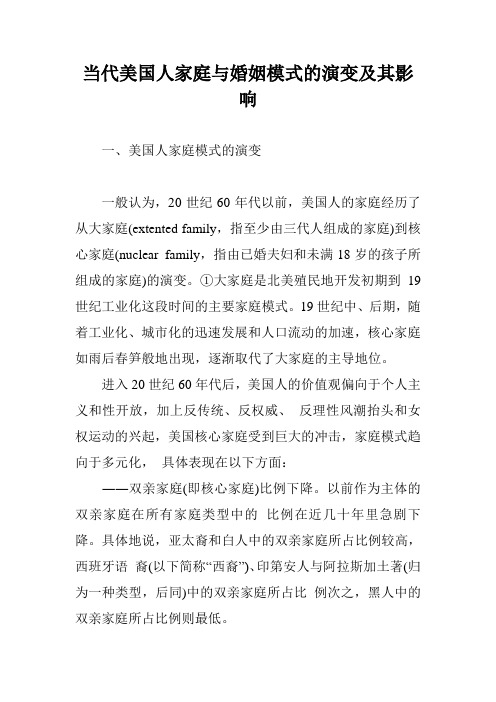
当代美国人家庭与婚姻模式的演变及其影响一、美国人家庭模式的演变一般认为,20世纪60年代以前,美国人的家庭经历了从大家庭(extented family,指至少由三代人组成的家庭)到核心家庭(nuclear family,指由已婚夫妇和未满18岁的孩子所组成的家庭)的演变。
①大家庭是北美殖民地开发初期到19世纪工业化这段时间的主要家庭模式。
19世纪中、后期,随着工业化、城市化的迅速发展和人口流动的加速,核心家庭如雨后春笋般地出现,逐渐取代了大家庭的主导地位。
进入20世纪60年代后,美国人的价值观偏向于个人主义和性开放,加上反传统、反权威、反理性风潮抬头和女权运动的兴起,美国核心家庭受到巨大的冲击,家庭模式趋向于多元化,具体表现在以下方面:――双亲家庭(即核心家庭)比例下降。
以前作为主体的双亲家庭在所有家庭类型中的比例在近几十年里急剧下降。
具体地说,亚太裔和白人中的双亲家庭所占比例较高,西班牙语裔(以下简称“西裔”)、印第安人与阿拉斯加土著(归为一种类型,后同)中的双亲家庭所占比例次之,黑人中的双亲家庭所占比例则最低。
――单亲家庭数量增多。
单亲家庭尤其是女性单亲家庭数量明显增长。
在各族裔中,黑人单亲家庭比例最高,其女性单亲家庭比例高达45.1%;印第安人与阿拉斯加土著、西裔次之;亚太裔和白人单亲家庭比例最低。
――单身户增多。
自20世纪60年代以来,美国单身户数量不断增加,40余年间增长了3.27倍。
1960年,美国的单身户为689.6万户,占总户数的13.1%;到1980年和2003年,美国的单身户分别增长到1829.6万户和2943.1,万户,分别占总户数的15.4%和17.7%。
其他家庭模式还包括非婚同居家庭、同性恋家庭等,详见本文第二部分。
另外,当代美国人的家庭户和非家庭户的规模也在日益缩小。
1970-2000年间,5人及5人以上的住户所占比例从20.9%减少到10.4%,而1人和2人的住户所占比例却分别从17.1%和28.9%增长到25.5%和33.1%。
19世纪美国黑奴文化的产生与发展

19世纪美国黑奴文化的产生与发展19世纪中叶,美国南方12个州的奴隶数量高达400万,占到全国人口的四分之一。
这些黑人奴隶遭受着残酷的奴役和压迫,生活在黑暗的角落里。
但他们在劳动、生活、信仰等方面形成了自己的文化,正是这种文化促进了黑人奴隶从压迫中走向解放和进步。
一、生活中的黑奴文化生活中的黑奴文化来源于黑奴对生活的感受,表现出的天真、朴实、虔诚以及情感的丰富。
在奴隶社会中,黑人奴隶的生活常常被其奴主控制和约束。
为了维护个性和自尊心,黑人奴隶们把心灵倾注在生活中细节的创造和经验上,形成了自己独特的文化。
1.音乐文化音乐是19世纪黑人奴隶文化的最重要的表现。
在奴隶制度下,有许多禁令,奴主们禁止黑人奴隶们学习阅读、写作以及弹奏乐器。
但这并没有扼灭奴隶们对音乐艺术的热爱和创造欲望。
奴隶们用手拍腿,用嘴唱歌,用尽力气扮演各种乐器,将他们的情感表达出来。
类似拍板舞、摇摆舞、大步舞等传统舞蹈,都是黑人奴隶自己创造并流传下来的。
因此,音乐艺术是奴隶文化的重要标志和灵魂。
2.口头文化口头传统的文化是指通过口非书面传承的文化。
在奴隶主高压下,黑人奴隶只能通过口头流传来交流娱乐、获取信息。
在这种情况下,黑人奴隶口头文化的传承变得格外重要。
奴隶们以叙故事、谚语、俚语、祷文等形式,记录并传承了自己对生活的理解,表达了对人生价值和意义的简洁而深刻的理解。
这一口头文化的传承延续到了现代,并成为了美国黑人文化的重要组成部分。
二、基督教信仰黑人奴隶的历史是一个长久痛苦的抗争史,然而,正是基督教的信仰,给黑人奴隶们带来了安慰,照亮了他们的未来。
在奴隶主和州政府的压迫下,黑人奴隶们找到了自己的信仰,形成了独特的宗教文化。
奴隶们在随地举行的唱诗班、祷告会中寻求心灵抚慰,将基督教的慈爱之神作为自己信仰的本源。
越来越多的黑人奴隶开始加入教会,并找到了对抗奴隶制和压迫的方式。
三、黑人奴隶文化的历史地位在19世纪,黑人奴隶文化的地位是非常独特的。
19世纪下半叶美国南部黑人妇女的生活及其社会地位
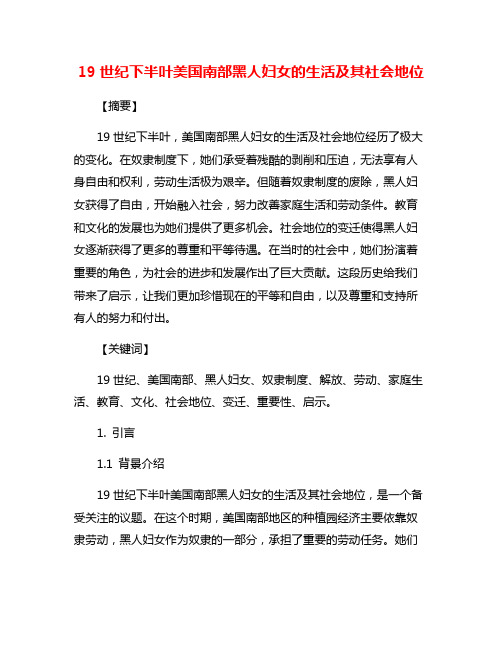
19世纪下半叶美国南部黑人妇女的生活及其社会地位【摘要】19世纪下半叶,美国南部黑人妇女的生活及社会地位经历了极大的变化。
在奴隶制度下,她们承受着残酷的剥削和压迫,无法享有人身自由和权利,劳动生活极为艰辛。
但随着奴隶制度的废除,黑人妇女获得了自由,开始融入社会,努力改善家庭生活和劳动条件。
教育和文化的发展也为她们提供了更多机会。
社会地位的变迁使得黑人妇女逐渐获得了更多的尊重和平等待遇。
在当时的社会中,她们扮演着重要的角色,为社会的进步和发展作出了巨大贡献。
这段历史给我们带来了启示,让我们更加珍惜现在的平等和自由,以及尊重和支持所有人的努力和付出。
【关键词】19世纪、美国南部、黑人妇女、奴隶制度、解放、劳动、家庭生活、教育、文化、社会地位、变迁、重要性、启示。
1. 引言1.1 背景介绍19世纪下半叶美国南部黑人妇女的生活及其社会地位,是一个备受关注的议题。
在这个时期,美国南部地区的种植园经济主要依靠奴隶劳动,黑人妇女作为奴隶的一部分,承担了重要的劳动任务。
她们不仅要从事繁重的农田劳动,还要负责家庭的日常事务,如烹饪、清洁和照顾子女。
随着南方奴隶制度的废除,黑人妇女的生活状况有了一定程度的改善,但仍然面临着许多挑战。
她们在劳动方面仍然处于劣势地位,往往只能从事粗重的体力劳动,收入微薄,生活贫困。
受到种族歧视的影响,黑人妇女往往无法获得良好的教育和文化资源,限制了她们的社会发展。
随着社会的变迁和种族关系的演变,黑人妇女的社会地位逐渐得到提升。
她们开始参与社会运动和政治活动,争取平等权利和地位。
在今日社会,我们可以从19世纪下半叶美国南部黑人妇女的生活经历中,看到她们在社会中的重要性,以及对我们的启示。
1.2 研究意义19世纪下半叶美国南部黑人妇女的生活及其社会地位是一个备受关注的话题。
研究这一主题的意义在于深入探讨黑人妇女所面临的困境和挑战,以及她们在社会中的地位和作用。
通过对黑人妇女生活的研究,我们可以更好地了解奴隶制度和种族隔离对她们的影响,揭示她们在家庭、劳动和教育领域的种种困境,以及她们如何通过抗争和努力来争取平等权利。
当代美国家庭的多元化趋势
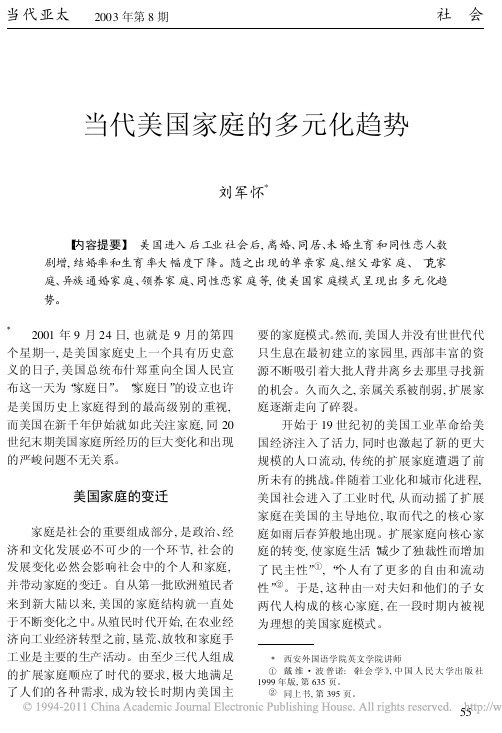
当代美国家庭的多元化趋势刘军怀*【内容提要】 美国进入后工业社会后,离婚、同居、未婚生育和同性恋人数剧增,结婚率和生育率大幅度下降。
随之出现的单亲家庭、继父母家庭、丁克家庭、异族通婚家庭、领养家庭、同性恋家庭等,使美国家庭模式呈现出多元化趋势。
2001年9月24日,也就是9月的第四个星期一,是美国家庭史上一个具有历史意义的日子,美国总统布什郑重向全国人民宣布这一天为“家庭日”。
“家庭日”的设立也许是美国历史上家庭得到的最高级别的重视,而美国在新千年伊始就如此关注家庭,同20世纪末期美国家庭所经历的巨大变化和出现的严峻问题不无关系。
美国家庭的变迁家庭是社会的重要组成部分,是政治、经济和文化发展必不可少的一个环节,社会的发展变化必然会影响社会中的个人和家庭,并带动家庭的变迁。
自从第一批欧洲殖民者来到新大陆以来,美国的家庭结构就一直处于不断变化之中。
从殖民时代开始,在农业经济向工业经济转型之前,垦荒、放牧和家庭手工业是主要的生产活动。
由至少三代人组成的扩展家庭顺应了时代的要求,极大地满足了人们的各种需求,成为较长时期内美国主要的家庭模式。
然而,美国人并没有世世代代只生息在最初建立的家园里,西部丰富的资源不断吸引着大批人背井离乡去那里寻找新的机会。
久而久之,亲属关系被削弱,扩展家庭逐渐走向了碎裂。
开始于19世纪初的美国工业革命给美国经济注入了活力,同时也激起了新的更大规模的人口流动,传统的扩展家庭遭遇了前所未有的挑战。
伴随着工业化和城市化进程,美国社会进入了工业时代,从而动摇了扩展家庭在美国的主导地位,取而代之的核心家庭如雨后春笋般地出现。
扩展家庭向核心家庭的转变,使家庭生活“减少了独裁性而增加了民主性” ,“个人有了更多的自由和流动性” 。
于是,这种由一对夫妇和他们的子女两代人构成的核心家庭,在一段时期内被视为理想的美国家庭模式。
同上书,第395页。
戴维・波普诺:《社会学》,中国人民大学出版社1999年版,第635页。
美国家庭

美国家庭美国人继承欧洲的文化传统,受欧洲传统宗教尤其是新教思想的熏陶,加上他们自己独特的文化传统,他们既没有三四代同堂的家庭模式,也没有中国传统的孝顺思想,同时又形成了一种不同于欧洲人的家庭价值观。
概括来讲,美国人家庭价值观可总结为:个人独立、个人权利、自由平等这12个字。
个人独立美国家庭中的独立意味着每一个成员有权不受别的成员的控制或约束而做出自己的选择。
在交友、结婚、个人的发展等问题上个人有权做出决定,任何人不得横加干涉。
在美国家庭中,孩子从小就被灌输独立意识,父母一般让孩子拥有自己的空间。
美国大众观点认为,父母培养孩子的目标是使孩子在18岁左右能成为独立自主、自食其力并对自我行为负责的独立的个人。
孩子长大后上什么大学、学什么专业、毕业后从事什么职业由他自己决定。
许多子女一上大学便离家单住,开辟自己的新空间。
孩子一般不选择在自己家住的城市上大学,而是到一个新地方去。
上学期间孩子都半工半读,自食其力。
婚姻也是完全自主的,不喜欢父母的干预,家庭与社会也倾向于由个人自己决定。
这种独立精神使美国父母对孩子的权威大大削弱。
美国的年轻人一到成年,服从父母的思想马上减弱,成为自己思想的主人,也使他们成为自己行动的主人。
在美国,严格来说没有青春期。
童年一结束,他就成人,开始走自己的路。
个人权利美国人在家庭中的权利意识极强。
美国家庭中的权利意识是指每一个成员以自己为中心,而不是以整个家庭为中心。
家庭中的每个成员在自己的事情上都享有不可侵犯的个人权利,其他成员无权干涉。
如谈恋爱、结婚、生育、求职、选择安家地点等问题上,都是个人说了算,别人无权代替作决定。
美国人认为,作为个体的人,他应该有自己的尊严和独立的人格,在任何时候、对任何人都不能轻易放弃自己的权利,朋友间如此,亲人间也是如此。
美国人认为隐私权是一项至关重要的个人权利。
它是个人、家庭或群体的心理需求与社会需求之一,有时它又是一种为实现某一目标而暂时需要的心理态势。
美国十九世纪(上)-浪漫主义
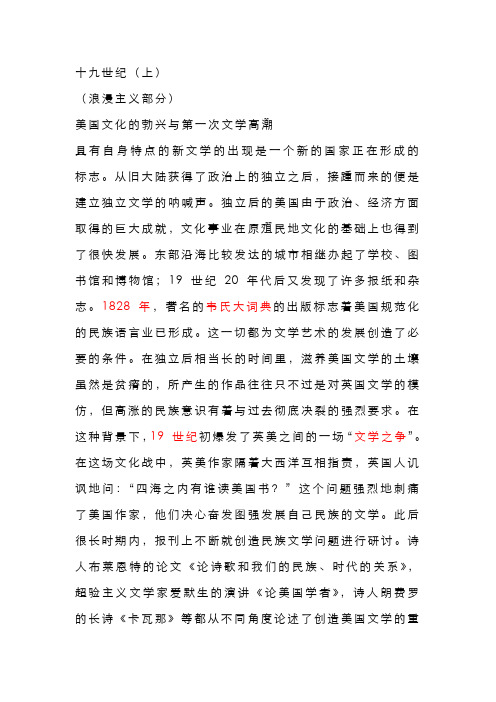
十九世纪(上)(浪漫主义部分)美国文化的勃兴与第一次文学高潮具有自身特点的新文学的出现是一个新的国家正在形成的标志。
从旧大陆获得了政治上的独立之后,接踵而来的便是建立独立文学的呐喊声。
独立后的美国由于政治、经济方面取得的巨大成就,文化事业在原殖民地文化的基础上也得到了很快发展。
东部沿海比较发达的城市相继办起了学校、图书馆和博物馆;19 世纪20 年代后又发现了许多报纸和杂志。
1828 年,著名的韦氏大词典的出版标志着美国规范化的民族语言业已形成。
这一切都为文学艺术的发展创造了必要的条件。
在独立后相当长的时间里,滋养美国文学的土壤虽然是贫瘠的,所产生的作品往往只不过是对英国文学的模仿,但高涨的民族意识有着与过去彻底决裂的强烈要求。
在这种背景下,19 世纪初爆发了英美之间的一场“文学之争”。
在这场文化战中,英美作家隔着大西洋互相指责,英国人讥讽地问:“四海之内有谁读美国书?”这个问题强烈地刺痛了美国作家,他们决心奋发图强发展自己民族的文学。
此后很长时期内,报刊上不断就创造民族文学问题进行研讨。
诗人布莱恩特的论文《论诗歌和我们的民族、时代的关系》,超验主义文学家爱默生的演讲《论美国学者》,诗人朗费罗的长诗《卡瓦那》等都从不同角度论述了创造美国文学的重要性。
美国19 世纪浪漫主义文学运动就是当时社会发展的产物,它的形成和发展与当时的整个历史时代密不可分的。
19 世纪起,由于美国政权不断巩固,经济发展逐步走上正轨,从而进入了这个世纪前60 年第一个大规模的经济腾飞时期。
1801 年,杰弗逊就任总统,在政治上推行了一条更加符合国家、民族和民众利益的路线,使当时的资产阶级民主空气为之一振。
1814 年,第二次独立战争的胜利,最后清除了英国殖民主义势力在美国的残余,为年轻共和国的独立自主、稳步发展提供了主权上的保证。
从1814 年到1861 年南北战争爆发之前,美国的工业总产值增长了10 倍,跃居世界第四位。
19 世纪初,在英法战争、欧洲混乱之际,美国大力发展贸易,掌握了世界贸易的三分之一。
littlewomen读书笔记

《Little Women》读书笔记第一章:对《Little Women》的初步印象1.1 《Little Women》是一部经典的文学作品,首次出版于1868年,作者是美国作家路易莎·梅·奥尔科特。
这部小说以四个姐妹的成长故事为主线,展现了她们在19世纪美国的家庭生活和个人成长。
1.2 读完《Little Women》给我的第一印象是故事情节跌宕起伏,娓娓道来,吸引人的同时也给了人许多的启示和感悟。
1.3 所有姐妹中我最喜欢的是乔,她勇敢坚毅,喜欢写作并且有追求,这一点让我感到深深敬佩。
第二章:深入探讨姐妹情谊2.1 《Little Women》中最吸引人的地方之一是四个姐妹间的深厚情谊。
她们彼此支持着对方追求自己的梦想,即使经历了风风雨雨,依然坚定地相互支持。
2.2 从故事中可以感受到她们之间的友情,不仅让人觉得温暖,也让人思考着自己与身边朋友之间的关系。
2.3 在现实生活中,我们也应该像这些姐妹一样,相互扶持,守望相助。
第三章:成长与价值观的变迁3.1 《Little Women》描述了四个姐妹从少女到成年人的成长历程,她们的个性、理想和追求在这个过程中也发生了巨大的变化。
3.2 通过这些变迁,作者给我们传达了许多关于友情、家庭、责任和自我认知方面的信息,让我们对价值观念有了更深入的思考。
3.3 这部小说也让我意识到了成长是一个不断变化和接受挑战的过程,我们需要不断调整自己的心态和价值观,以适应周围的环境。
总结与回顾通过阅读与撰写这篇《Little Women》读书笔记,我深入体会到了这部经典文学作品所传递的深刻内涵。
姐妹间的情谊、成长历程和对价值观的思考,都给予了我不少启示和感悟。
这部小说不仅是一部娱乐性的文学作品,更是一部富有教育意义的作品,让人不仅在情感上有所触动,同时也在思想上得到了空前的升华。
通过这篇读书笔记,希望读者们也能对这部小说有更深入的了解,从中受益匪浅。
《小妇人》读后感:探索女性成长与家庭价值的经典之作

《小妇人》读后感:探索女性成长与家庭价值的经典之作引言:路易莎·梅·奥尔科特的《小妇人》是一部描绘19世纪中叶美国家庭生活的经典小说。
通过马奇家四姐妹的成长故事,这部作品深刻地探讨了女性成长、家庭价值以及个人追求。
阅读这部小说,我深受感动,以下是我的一些感悟。
正文:一、四姐妹的个性与成长小说中马奇家的四姐妹——梅格、乔、贝丝和艾米,每个角色都具有鲜明的个性和不同的生活道路。
她们的故事让我感受到了女性角色的多样性和丰富性。
她们在面对生活挑战时展现出的坚韧不拔,激励着读者勇敢追求自己的梦想。
二、家庭关系的温馨描绘小说中对家庭关系的描绘充满了爱与温暖。
马奇家的姐妹们在经济困难和生活挑战面前相互扶持,共同成长。
这种家庭的和睦与支持,让我认识到家庭是人生中最宝贵的财富,无论面对何种困难,家人的爱都是最坚强的后盾。
三、乔的独立精神与追求乔是小说中最具代表性的角色之一,她热爱写作,追求独立,不愿意受到传统性别角色的束缚。
乔的形象特别让我印象深刻,她的故事激励了我,让我明白女性同样可以追求自己的事业和梦想,不必局限于社会的期望。
四、爱情与婚姻的多样展现小说中对爱情和婚姻的描写展现了不同类型的情感关系。
梅格和约翰的爱情故事,乔和劳里的深厚友谊,以及艾米和劳里的婚姻,都让我认识到每个人在爱情和婚姻中都有自己的选择和追求,没有固定的模式。
五、贝丝的善良与牺牲贝丝虽然在小说中的篇幅不多,但她的善良和牺牲精神却让人动容。
她的生命虽然短暂,但却照亮了周围人的生活,让我感受到了生命的脆弱和珍贵。
六、生活的挑战与希望小说的结局虽然带有一定的悲剧色彩,但也充满了希望。
姐妹们在面对生活挑战时的相互扶持和对未来的憧憬,让我明白,只要我们有爱和梦想,就能找到前进的动力。
结论:《小妇人》是一部充满智慧和情感的小说,它不仅让我感受到了家庭的温暖和姐妹情深,也启发了我对女性自我价值和社会角色的思考。
这部小说是对女性力量和精神的赞歌,也是对家庭和爱的美好颂扬。
美国文化研究里的消费主义问题

美国文化研究里的消费主义问题小引一“家庭主妇”的消费就是一个例子。
在19世纪的美国家庭里,男子挣钱养家,女子自然管起家事。
大家都期望如此,富裕的家庭也的确是这么安排的。
一部分人越来越富,阶级差别于是形成。
区分阶级的方式之一是看妇女的衣着。
对富裕的家庭来说,要保持上中产阶级的身份特征非常要紧。
劳动阶级妇女怎么也买不起紧身花边衣裙;一则太昂贵,一则干活不方便。
保持皮肤双手的白皙完美是富裕的标志,能看出属于哪个阶级。
皮肤完美白皙表明她不用干活。
这是上流社会奢侈消费的起因之一。
另一个起因是这一时期出现的妇女杂志。
这1890-1910年间,美国白领的薪水上涨了1/3。
成衣的大量生产使人们对时装产生兴趣。
消费主义在19世纪美国兴起的另一个因素是百货公司的发展。
SEARS等大百货公司的邮购目录成为新兴的中产阶级家庭的“愿望清单”。
那时侯这种小册子已经开始做衣柜、省力用具和罐头冷冻加工食品的广告了。
梅西(MACY’S)等大百货公司把现成的时尚货物带到许多大城市。
这就为美国妇女提供逛商店的机会,逛的结果难免消费。
百货公司促进了消费。
消费风的兴起尤其对美国妇女产生了大影响。
她们在购物、做饭、工作休闲等方面都受消费之风的影响。
美国妇女还加入了百货公司售货员和餐厅招待的行列。
19世纪末20世纪初美国城市休闲方式的特点是休闲的场所都在公园、舞厅、沙龙、电影院、赛马场、体育馆等公共场地。
这一点是20世纪末的美国人抱怨失去了的东西。
美国妇女这一时期越来越积极参加高尔夫、网球、自行车、槌球等户外运动了。
这些项目的一部分仍然是今天消费主义文化的内容。
此外,城市剧场把音乐喜剧这一最有美国特色的娱乐形式带给了观众。
有一个叫欧文·伯林(IRVING BERLIN)的人为音乐剧写了1000多首歌,现今的大众文化生产者也鲜能望其项背。
托马斯·爱迪森根据音乐喜剧制作了电影短片。
城市中产阶级私人休闲领地也有新变化:室内照明开始有了电灯汽灯,如此,阅读廉价通俗小说之类的消费读物就容易了。
小妇人故事梗概

小妇人故事梗概《小妇人》是美国著名作家路易莎·梅·奥尔科特的代表作之一,是一部以19世纪美国南北战争时期的家庭生活为背景的长篇小说。
小说以四个姐妹为主角,描述了她们在贫困中成长,追求幸福的故事。
以下是《小妇人》的故事梗概。
故事以四个姐妹为主线,她们分别是长女梅格、次女乔、三女贝丝和四女艾米。
她们的父亲参加了南北战争,家境贫困,母亲为了维持家庭生计,经营着一家小学校。
四姐妹性格迥异,但彼此之间却有着深厚的感情。
梅格是一个温柔贤惠的姑娘,她渴望过上富裕的生活,嫁给了一个贫穷的教师约翰。
乔是一个刚毅独立的女孩,她渴望成为一名作家,拒绝了富有的劳里的求婚。
贝丝是一个纯洁善良的姑娘,她热爱音乐,善良地帮助着身边的人。
艾米是一个浪漫爱美的姑娘,她渴望成为一名画家,追求着高贵的生活。
故事情节主要围绕四姐妹的成长和她们在生活中所经历的各种挫折展开。
梅格在婚后生活中经历了贫困和挫折,但她始终保持着乐观和善良的态度。
乔在寻找自己的人生道路上历经了许多挫折,但她始终坚持自己的梦想,最终成为了一名成功的作家。
贝丝在照顾生病的邻居时感染了重病,最终离开了人世,给家人带来了巨大的伤痛。
艾米在追求高尚生活的过程中经历了许多挫折,但她始终保持着乐观和积极的态度,最终实现了自己的梦想。
故事最终以四姐妹各自在生活中找到了自己的幸福为结局,梅格过上了幸福美满的生活,乔成为了一名成功的作家,贝丝虽然离开了人世,但她的善良和纯洁的形象一直留存在了家人的心中,艾米成为了一名成功的画家。
四姐妹在生活中经历了许多挫折,但她们始终保持着乐观和善良的态度,最终找到了自己的幸福。
《小妇人》通过四姐妹的故事,展现了19世纪美国南北战争时期的家庭生活,以及女性在家庭和社会中所扮演的角色。
小说以其鲜明的人物刻画和深刻的情感描写,成为了一部经典的家庭文学作品,深受读者喜爱。
小妇人小说故事简介

小妇人小说故事简介《小妇人》是美国作家路易莎·梅·奥尔科特于1868年出版的一部经典小说,该小说以四个姐妹之间的情感纠葛和成长历程为主线,展现了19世纪美国底层家庭的生活状态和社会风貌。
小说情节跌宕起伏,情感丰富,是一部不可多得的家庭文学作品。
故事的背景设定在美国南北战争时期,讲述了马奇家的四个姐妹——梅格、乔、贝丝和艾米的成长故事。
她们的父亲在战争中参加了抗争,母亲则在家中照料着四个女儿。
在父亲不在家的时候,四姐妹和母亲一起生活,他们在贫困的环境中相互扶持,共同面对生活的挑战。
梅格是姐妹中最大的,她温柔贤惠,对家庭非常负责,常常承担起照顾妹妹们和家务的重任。
乔是个性张扬,勇敢坚强的女孩,她有着自己的梦想和追求,渴望成为一名作家。
贝丝是个性善良、纯洁的女孩,她喜欢音乐,乐于奉献,对家人和朋友都充满爱心。
艾米则是最小的,她爱美、爱梦想,渴望成为一名画家。
四姐妹在家庭中相互扶持,共同成长。
她们一起度过了快乐的时光,也一起面对了生活的困难和挑战。
她们通过努力学习,不断提升自己的能力,最终实现了各自的梦想。
梅格嫁给了她所爱的人,过上了幸福美满的生活;乔通过自己的努力成为了一名成功的作家,实现了自己的文学梦想;贝丝则在照顾家人的同时,用自己的音乐才华温暖了周围的人;艾米则在追求艺术的道路上不断努力,最终成为了一名杰出的画家。
《小妇人》通过四个姐妹的成长故事,展现了女性在19世纪社会中的坚韧和勇敢,呈现了家庭、友情、爱情、梦想等多种情感。
小说以其鲜明的人物性格和丰富的情感描写,深刻地表现了女性的内心世界和对生活的热爱,成为了一部经典的家庭文学作品。
总的来说,《小妇人》是一部充满温情和感动的小说,它不仅展现了19世纪美国社会的风貌,更通过四个姐妹的成长故事,传递出了关于家庭、友情、爱情和梦想的深刻思考。
这部小说不仅在当时引起了广泛的关注,也成为了后世家庭文学的经典之作,深受读者喜爱。
19世纪下半叶美国南部黑人妇女的生活及其社会地位
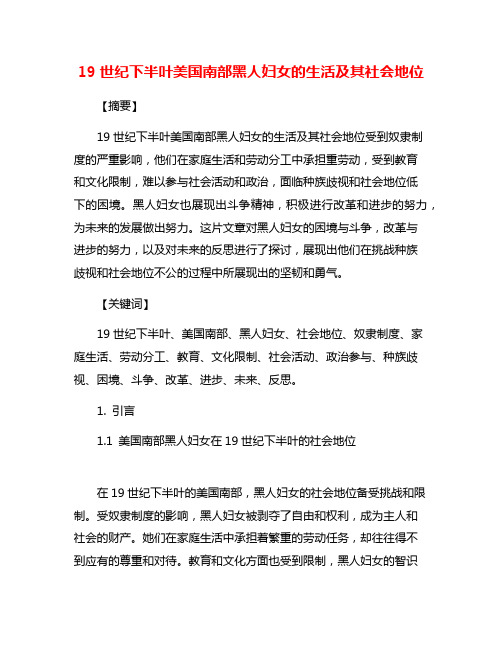
19世纪下半叶美国南部黑人妇女的生活及其社会地位【摘要】19世纪下半叶美国南部黑人妇女的生活及其社会地位受到奴隶制度的严重影响,他们在家庭生活和劳动分工中承担重劳动,受到教育和文化限制,难以参与社会活动和政治,面临种族歧视和社会地位低下的困境。
黑人妇女也展现出斗争精神,积极进行改革和进步的努力,为未来的发展做出努力。
这片文章对黑人妇女的困境与斗争,改革与进步的努力,以及对未来的反思进行了探讨,展现出他们在挑战种族歧视和社会地位不公的过程中所展现出的坚韧和勇气。
【关键词】19世纪下半叶、美国南部、黑人妇女、社会地位、奴隶制度、家庭生活、劳动分工、教育、文化限制、社会活动、政治参与、种族歧视、困境、斗争、改革、进步、未来、反思。
1. 引言1.1 美国南部黑人妇女在19世纪下半叶的社会地位在19世纪下半叶的美国南部,黑人妇女的社会地位备受挑战和限制。
受奴隶制度的影响,黑人妇女被剥夺了自由和权利,成为主人和社会的财产。
她们在家庭生活中承担着繁重的劳动任务,却往往得不到应有的尊重和对待。
教育和文化方面也受到限制,黑人妇女的智识和才能无法得到充分发展。
在社会活动和政治参与方面,黑人妇女常常被排除在外,无法享有平等的权利和机会。
种族歧视和社会地位的不平等更加加剧了黑人妇女的困境,使她们面临着巨大的挑战和难题。
尽管面临重重困难,黑人妇女并没有放弃,她们展现出了坚强和勇气,努力争取自由和权利。
通过不懈的努力和斗争,一些黑人妇女取得了一些改善,为自己和同胞争取了一些权利。
她们的努力和进步不仅为当时的社会带来了一丝曙光,也为未来的发展奠定了基础。
黑人妇女的故事和经历激励着我们深刻思考和反思,从中汲取力量和智慧,为创造更加公正和平等的社会而努力。
2. 正文2.1 奴隶制度对黑人妇女的影响19世纪下半叶,美国南部的黑人妇女面临着严重的奴隶制度影响。
奴隶制度使得黑人妇女成为主人的财产,她们被剥夺了基本的人权和自由。
黑人妇女常常被迫参与繁重的体力劳动,无论是在田地里劳作或者在主人家中做家务,她们没有选择权和自我决定权,经常遭受身体和精神上的虐待。
《小妇人》的家庭温馨与女性成长

《小妇人》的家庭温馨与女性成长《小妇人》是一部充满温情与力量的作品,它以细腻的笔触描绘了一个普通家庭中姐妹们的成长历程,展现了家庭的温馨以及女性在那个时代所面临的挑战与突破。
故事发生在 19 世纪的美国,马奇一家过着虽不富裕但充满爱的生活。
父亲远在战场,母亲带着四个性格迥异的女儿——梅格、乔、贝丝和艾米,努力支撑着这个家。
在这个家庭中,温馨是无处不在的。
母亲总是以她的智慧和爱,引导着女儿们如何面对生活中的困难和挫折。
家庭聚会时,大家围坐在一起分享彼此的喜怒哀乐,那种浓浓的亲情让人感到无比温暖。
即使生活拮据,她们依然相互扶持,共同度过一个又一个难关。
梅格,作为长女,她渴望爱情和美好的家庭生活。
她向往着华丽的服饰和舞会,但最终在爱情面前,她选择了与贫穷但善良的布鲁克先生结婚。
她明白了真正的幸福并非来自物质的丰富,而是来自于相互的理解和支持。
她在家庭与个人梦想之间找到了平衡,展现出了女性在婚姻中的成长与担当。
乔,是一个独立自主、充满激情和梦想的女孩。
她热爱写作,渴望通过自己的努力在文学领域闯出一片天地。
她性格直爽,敢于挑战传统的女性角色定位。
在追求梦想的道路上,她遭遇了许多挫折,但从未放弃。
她的坚持和努力让我们看到了女性在追求自我价值实现过程中的坚韧与勇气。
同时,她在与姐妹们的相处中,也学会了关心他人,理解家庭的重要性。
贝丝,温柔善良,安静内敛。
她喜欢音乐,总是默默地为家人付出。
然而,命运却对她不公,她身患重病。
但在生病期间,她依然保持着乐观和坚强,她的存在让这个家庭更加团结和亲密。
她的离去让姐妹们深刻地体会到生命的脆弱和珍贵,也促使她们更加珍惜彼此和眼前的生活。
艾米,是个有着艺术天赋且有野心的女孩。
她清楚地知道自己想要什么样的生活,并为之努力奋斗。
她在追求艺术的道路上不断成长,从一个有些任性的小女孩逐渐变得成熟懂事。
这个家庭中的女性成长并非一帆风顺,她们在不断地犯错、反思和改正中前行。
家庭的温馨给予了她们足够的勇气和力量去面对外界的风雨。
《小妇人》的作文

《小妇人》的作文《小妇人》是美国作家路易莎·梅·奥尔科特的代表作,以四个姐妹的成长故事为主线,展现了19世纪美国社会的伦理观念、家庭价值和妇女地位的变迁。
本文将从人物刻画、家庭生活和社会背景三个方面来探究《小妇人》的主题与意义。
一、人物刻画《小妇人》以美林家的四个姐妹为中心人物,每个姐妹都有鲜明的个性和独立的特点。
梅格是姐妹中最为贤淑传统的一位,她尊重传统道德,渴望嫁入富有的家庭;乔是一个自由奔放、热情活泼的女孩,她追求自由和独立,渴望成为一名作家;贝丝是一个纯真善良的姑娘,她喜欢音乐,善良的她与人为善,但身体健康出了问题,导致她的人生轨迹发生了变化;艾米是最小的妹妹,生性洒脱,喜欢追求浪漫和时尚,同时她也追求权力和金钱。
通过这四个人的塑造,梅·奥尔科特展示了不同类型的女性形象和不同人生选择所带来的结果。
二、家庭生活《小妇人》一直将家庭视为一个重要的主题。
父亲在战争中服务,由于家庭财政紧张,四个姐妹和母亲被迫过起了朴素的生活。
然而,这并没有消磨掉姐妹们之间的感情。
她们相互扶持,共同度过了很多困难和艰辛的时刻。
她们共同学习和成长,彼此鼓励和支持。
通过描述姐妹情深以及共同努力奋斗的家庭生活,梅·奥尔科特传达了家庭和团结的重要性。
三、社会背景《小妇人》发生在19世纪的美国社会,这个时代正值女性地位的变迁时期。
书中描绘了当时社会对女性的期望和限制。
在这个时代,女性的角色被限制在家庭和婚姻之中,她们没有被赋予参与社会和职业发展的机会。
然而,四个姐妹中的乔和艾米并没有完全接受这种命运,她们追求自由和独立,积极争取她们自己的人生。
通过描写姐妹们的成长和她们对传统观念的挑战,梅·奥尔科特探讨了妇女地位的变革和女性自主的重要性。
总结:《小妇人》通过细腻而真实的描写,展示了19世纪美国社会的伦理观念、家庭价值和妇女地位的变迁。
通过人物刻画,我们看到了不同类型的女性形象和不同人生选择所带来的结果。
黑布林小妇人书后判断题

黑布林小妇人书后判断题标题:黑布林小妇人书后判断题导言:《黑布林小妇人》是美国作家路易莎·梅奇尔所创作的经典小说,它以四个姐妹的成长故事为主线,展现了19世纪美国家庭生活的方方面面。
本文将以此为背景,探讨与《黑布林小妇人》书后判断题相关的一些观点,以及对这个主题的个人理解。
一、《黑布林小妇人》书后判断题概述1.1 梅格结婚后是否过上了幸福的生活?《黑布林小妇人》中,梅格姐姐嫁给了劳伦斯先生,尽管他们过着朴实而节俭的生活,但梅格从中找到了幸福。
劳伦斯先生尽管身份低微,但他有一颗善良的心,对梅格关心备至。
虽然生活简单,但他们相互扶持,展现出婚姻中的平等与和谐。
1.2 贝丝的死对接下来的故事发展有何影响?贝丝是四姐妹中最善良、喜欢音乐的一个。
她积极向内外传递着温暖与希望,但因病去世,给家人带来了深深的悲痛。
她的离世让其他三位姐妹更加珍惜彼此,推动了她们在事业与婚姻上迈出新的一步。
1.3 乔在小说中是否实现了自己的作家梦想?乔是四姐妹中最不拘小节、思想最开放的一个。
她梦想成为一名作家,并积极地追求着自己的梦想。
她在小说中遭遇了作品被拒绝、遇到写作瓶颈等挫折,但通过坚持不懈,最终实现了自己的作家梦想。
1.4 路易莎·梅奇尔在《黑布林小妇人》中想要传达什么?通过《黑布林小妇人》,梅奇尔想要传递出一个普遍的信息:家庭的重要性。
她通过四姐妹之间的互动,展示了家庭成员之间相互支持、理解与尊重的重要性。
无论是在幸福或困难之中,家庭的力量是无可替代的。
梅奇尔也强调了女性独立、追求梦想的重要性,以及对社会现象的关注。
二、个人观点和理解2.1 家庭的重要性在我看来,梅奇尔所传达的家庭的重要性是非常真实和深刻的。
家庭是一个人成长和发展的基石,它提供了温暖、理解和支持。
正如《黑布林小妇人》中的四个姐妹一样,他们在彼此之间相互扶持、互相激励,并共同面对生活中的挑战。
2.2 追求梦想的意义乔是一个积极向上、充满梦想的角色。
- 1、下载文档前请自行甄别文档内容的完整性,平台不提供额外的编辑、内容补充、找答案等附加服务。
- 2、"仅部分预览"的文档,不可在线预览部分如存在完整性等问题,可反馈申请退款(可完整预览的文档不适用该条件!)。
- 3、如文档侵犯您的权益,请联系客服反馈,我们会尽快为您处理(人工客服工作时间:9:00-18:30)。
Family Life, 19th-Century FamiliesOnly in the late 18th and early 19th centuries did ideas of affectionate marriages and loving, sentimental relations with children become dominant in American family life. These attitudes first took hold among the urban, educated wealthy and middle classes, and later spread to rural and poorer Americans. This change was due to the growth and increasing sophistication of the economy, which meant that economic issues became less pressing for families and production moved outside the home to specialized shops and factories. With more leisure time and greater physical comfort, people felt that happiness, rather than simple survival, was possible. English philosopher John Locke’s theory that human beings are born good, wi th their minds as blank slates, contrasted with traditional Christian beliefs that children were sinful by nature. If this blank-slate theory is correct, then goodness can be instilled in children by showering them with kindness and love and by shielding them from the bad things in this world.Additionally, the psychological theory of sensibility, another 18th-century idea, argued that positive feelings such as friendship, happiness, sympathy, and empathy should be cultivated for a civil life of reason. By the 19th century, romanticism and sentimentality put even more emphasis on emotional attachment and the cultivation of feeling. New ideas about human equality and liberty undermined older notions of hierarchy and order. Americans applied the political ideal of “Life, Liberty, and the pursuit of Happiness” espoused in the Declaration of Independence to family life. Husbands were to rule, but with affection and with their wives’ interests at heart. Wives obeyed, not out of force, but out of love. Parents sought the affection of their children, not their economic contributions. This was the new ideal, but old habits died slowly. Authority, inequality, and violence declined but never entirely disappeared.By the end of the 18th century and into the 19th century, marriage was undertaken for affection, not for economic reasons. Courtship became more elaborate and couples had more freedom. They attended dances, church socials, picnics, and concerts, and got to know one another well. After the wedding, couples went on honeymoons to have a romantic interlude before settling down to daily life. Raising children became the most important job a wife performed, and children were to be loved and sheltered. Physical punishment of children did not disappear, but it became more moderate and was combined with encouragement and rewards.Servants, apprentices, and others gradually dropped out of the definition of family. Servants no longer slept within the same house as the family, and apprentices rented rooms elsewhere. By the 19th century, the nuclear family, consisting of a father and mother and their dependent children, had become the model. The ideal, loving family could be found in magazines, poems, and religious tracts. Novels promoted romantic courtship and warned readers of insincere fortune hunters or seducers when seeking a husband or wife. Love and sincerity were advocated. Still, economic considerations did not entirely disappear. Wealthy women married wealthy men; poorer men married poorer women.The economic transformations of the Industrial Revolution in the 19th century brought about further changes in men’s and women's roles. Work was less likely to be done in the home, asfewer and fewer Americans lived on farms, and men left the home to work in offices and factories. Men assumed sole responsibility for the financial support of the family, becoming the breadwinners, a term coined in the early 19th century. Married women were not supposed to work for wages, and were considered too pure and innocent to be out in the working world. Women were supposed to devote themselves to domestic duties, and children were seen as young innocents who needed a mother's protection. Fathers had less and less to do with raising their children.Although the 19th-century ideal held that married women were not supposed to work, women did contribute to the family’s well-being. Wealthy women planned formal dinners, balls, and other social gatherings that were crucial to their husbands’ political and business success. Middle-class women sewed for what they called pin money, small amounts that frequently balanced the family budget. Married women in the middle and working classes took in boarders, sold hot lunches or pastries to neighbors, and saved money by doing their own baking, brewing, gardening, and other chores. It was also common in middle- and working-class families for sons to be sent to school, while their teenage sisters supported this schooling by working in a factory, teaching in elementary schools, or taking in sewing. Such work was considered acceptable as long as it was either done in the house or by unmarried young women.Many 19th-century American families did not fit into this nuclear family ideal, as it was expensive. High housing costs meant more people than just the nuclear family often lived under one roof. Extended families, including grandparents and other relatives, were most numerous in the mid-19th century. Immigrants clung to traditional extended-family forms, and poorer families often included grandparents, grandchildren, and sometimes aunts and uncles in order to maximize sources of income and save on rent. Men, women, and children worked long hours for low wages in dirty, cramped surroundings in the sweatshops of major cities. Although the ideal woman was supposed to be pure, innocent, and domestic, most poor women had to work. Taking in boarders, such as young men and women working in local factories, was another way that families earned money, although they gave up family privacy.Low wages during the early stages of the Industrial Revolution, in the first half of the 19th centurymeant that even young children sometimes had to work instead of being sheltered at home. In the poorest families, and particularly among newer immigrants, children younger than 12 often worked in factories or sold newspapers and trinkets on the streets. School was a luxury for some poor families because they needed the children’s income. Because of this, illiteracy rates actually rose during the early stages of the Industrial Revolution, even though public schools were more widely available.When husbands died or abandoned their families, women had no choice but to work, opening a shop if they had the capital or working in a sweatshop if they did not. Wages for women’s work were low, and prostitution, which offered more money, flourished in towns big and small. It was very difficult for a single mother or father to work and raise children, and children of single parents were often left at orphanages or simply abandoned to the streets. This was before Social Security, workers’ compensation, unemployment insurance, retirement funds, health insurance,and other private and public programs existed to aid families in times of crisis.American families made a variety of compromises in the face of economic hardship. In many southern and eastern European immigrant families, where it was more important for married women to stay at home, children were withdrawn from school and sent to work so their mother could run the household. Among African Americans living in the North, educating their children was the most important family goal, so wives joined their husbands in the workforce to enable children to stay in school. In some families, men had total control over finances; in others, wives handled the husband’s paycheck. In some families, resources went to the eldest son, so he could make money and later support his parents and siblings. In other families, all boys were treated equally or all boys and girls were equal. Some families valued close ties and insisted that older children settle near their parents, while others sent their sons out West, to the cities, or simply on the road in hopes of a better future.During the 19th century, the majority of Americans continued to live on farms where everyone in the family worked, even if it was in and around the house. Women on farms still worked as they had during colonial times, although by the 19th century, they were producing butter, eggs, cheese, and other goods to sell in the nearest city rather than to trade to neighbors. Sharecroppers and tenant farmers worked long and hard for only a fraction of their produce. School was out of the question for poor children in these circumstances. In the West, the difficulties of pioneering often meant that all members of the family worked. For most Americans, these alternate family arrangements were less than desirable. Most Americans sought the private, affectionate, comfortable family life with domestic wives, breadwinning husbands, and well-educated children.The dominance of the family ideal is only one aspect of life in the 19th century. The constant emphasis on family, domesticity, and children could be confining, so men and women developed interests outside of the home. The 19th century was a great age of organizations only for men, and fraternal groups thrived. Taverns and barrooms provided a space for men to make political deals, secure jobs, and be entertained. Men formed literary and scientific societies, labor organizations, reform groups, Bible study groups, and sports leagues.The 19th century was also a period of change for women. Married women in the 19th century, who had more education and fewer children than their predecessors, founded reform groups, debating societies, and literary associations. They involved themselves in school reform, health issues, women’s rights, temperance, child labor, and other public-policy issues. A few states in the West granted women full political rights. A women’s movement demanding equal rights, including the vote, gained strength after 1848. In the first half of the century, public education extended basic literacy to many poorer Americans, and in the second half of the century women's high schools and colleges were founded, along with coeducational colleges in the Mi dwest and West. Women’s occupational choices began to expand into the new fields of nursing, secretarial work, department store clerking, and more, although work was something a young woman did only until she married. Women who wanted a career had to forgo marriage.By the middle of the 19th century, many states had passed laws allowing women control over their possessions and wages. A few states allowed divorce on the grounds of physical abuse. New stereotypes appeared at the same time. In child custody cases, women, rather than fathers, were now given control of their children because women were considered natural child rearers. This practice would persist until the late 20th century, when shared custody arrangements became common.The rise of labor unions during the 19th century was instrumental in changing the nature of work and the shape of families in America. By the end of the century unions were demanding higher wages for men, so that they could provide the sole support for their families. The unions argued that women and children should refrain from paid labor rather than become unionized and press for higher wages. Behind these demands was the ideal of the breadwinner husband and the domestic wife. Unions also sought shorter workweeks to allow men to spend more time with their families.Family Life, African American Families under SlaveryAfrican family traditions, which varied according to national origin and religion, could not be replicated in the New World after Africans were forced into slavery. The slave trade was responsible for breaking up African families, and husbands, wives, and children were liable to be sold separately because U.S. law did not legally recognize their families.Enslaved Americans were denied a secure family life. Because enslaved men and women were property and could not legally marry, a permanent family could not be a guaranteed part of an African American slave’s life. They had no right to live or stay together, no right to their own children, and it was common for slave parents and children to live apart. Parents could not protect their children from the will of the master, who could separate them at any time. About one-third of slave families suffered permanent separation caused by the sale of family members to distant regions. This might occur to punish some infraction of plantation rules, to make money, to settle an estate after a death in the owner’s family, or to pay back a debt.For the majority of slaves, who lived on small plantations with only a few other enslaved people, marriage partners had to be found on other farms. Meetings between a husband and a wife could occur only with the permission of the husband’s owner. Children stayed with their mothers. Schooling was not an option for enslaved children, and in most states it was illegal to teach slaves to read and write. The most common reason for slaves to run away was to see family members, if only briefly, although slave women rarely took to the roads both because it was not safe for women to travel alone and because it was difficult to travel with young children. For enslaved people on large plantations, it might be possible to find a partner owned by the same master, although couples could be assigned to different parcels of land or different areas of the plantation, or even to the vacation or city homes of the owner. The Christmas holiday, the onebreak from work during the year for slaves, was anticipated with excitement because it allowed separated family members to meet and spend a week together. Despite the fragility of familial bonds under slavery, enslaved men and women considered themselves married, recognized their kin in the names they gave their children, looked after their relatives and friends in cases of separation, and protected each other as much as possible.Slavery and servitude was virtually abolished between the 1770s and the 1830s in the Northern states. This meant that African Americans could legally establish families in the North. Black churches married couples, baptized their children, and recorded the new surnames that former slaves chose for themselves. Benevolent societies looked out for their members' welfare. Slaves who escaped from slaveholding areas were sheltered and moved to safer locations. Mothers and fathers both worked so their children could become educated. Although African American families in the North faced discrimination and poverty, and worried about being kidnapped by slave catchers, they had hope of maintaining their family ties.。
